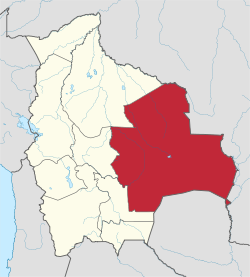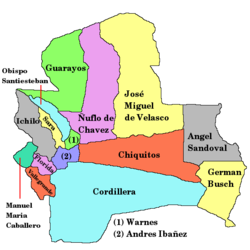Santa Cruz (departement)

Santa Cruz er det største departementet i Bolivia og har et areal på 370 621 km² og en befolkning på 2 657 762 (2012)[1]. Departementshovedstaden ligger i Santa Cruz de la Sierra. Departementet er rikt på naturgassressurser.
I departementet inngår Bolivias østlige, tropiske lavlandsområde som inngår i Amazonas-bekkenet. Santa Cruz by er Bolivias største og er sentrum for petroleumsutvinningen som foregår i området.[2][3][4] Departementet Santa Cruz er det største, mest folkerike og mest velstående i Bolivia.[5] Tidlig på 1900-tallet ble det anlagt jernbane til Brasil og Argentina. Fra 1920 ble oljeindustrien utviklet. På 1950 fikk Santa Cruz by veiforbindelse til Cochabamba og med det ble forbundet resten av Bolivia.[3]
Provinser i Santa Cruz[rediger | rediger kilde]
Santa Cruz er inndelt i 15 provinser (provincias):
| Provins | Hovedstad | Befolkning (2012)[1] |  |
|---|---|---|---|
| Andrés Ibáñez | Santa Cruz de la Sierra | 1 654 311 | |
| Ángel Sandoval | San Matías | 14 470 | |
| Chiquitos | San José de Chiquitos | 82 429 | |
| Cordillera | Lagunillas | 120 236 | |
| Florida | Samaipata | 32 842 | |
| Germán Busch | Puerto Suárez | 42 830 | |
| Guarayos | Ascención de Guarayos | 48 301 | |
| Ichilo | Buena Vista | 92 721 | |
| Ignacio Warnes | Warnes | 108 888 | |
| José Miguel de Velasco | San Ignacio de Velasco | 69 828 | |
| Manuel María Caballero | Comarapa | 23 309 | |
| Obispo Santistevan | Montero | 181 198 | |
| Sara | Portachuelo | 43 171 | |
| Vallegrande | Vallegrande | 26 576 | |
| Ñuflo de Chávez | Concepción | 116 652 |
Referanser[rediger | rediger kilde]
- ^ a b «Resultados - Censo de Población Vivienda 2012». ine.gob.bo. Arkivert fra originalen 23. mai 2018. Besøkt 29. mai 2018.
- ^ Van Der Stuyft, P., Gianella, A., Pirard, M., Cespedes, J., Lora, J., Peredo, C., ... & Boelaert, M. (1999). Urbanisation of yellow fever in Santa Cr uz, Bolivia. The Lancet, 353(9164), 1558-1562. «In 1998, the total population of the Santa Cruz region was 1 721 332, of which the city of Santa Cruz de la Sierra accounted for 891 287 inhabitants. The city is divided in 246 neighbourhoods, which vary in population size (3000–10 000 inhabitants). The mean population density of the town is 2903 inhabitants per km2.»
- ^ a b Crabtree, J., & Chaplin, A. (2013). Bolivia: processes of change. Zed Books Ltd..
- ^ Damms store leksikon. Oslo: Damm. 1989. ISBN 8251772583.
- ^ Markin, A., Barbero, R., Leow, J. J., Groen, R. S., Skow, E. J., Apelgren, K. N., ... & Nwomeh, B. C. (2013). A quantitative analysis of surgical capacity in Santa Cruz, Bolivia. Journal of surgical research, 185(1), 190-197.
